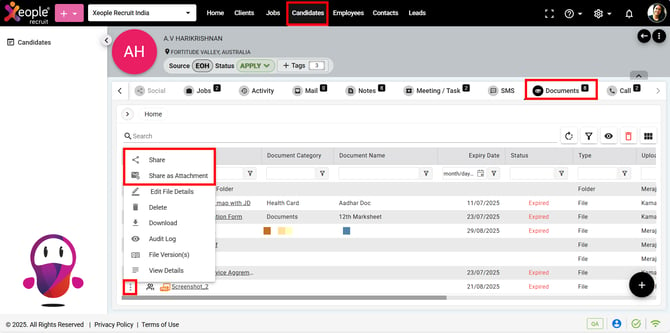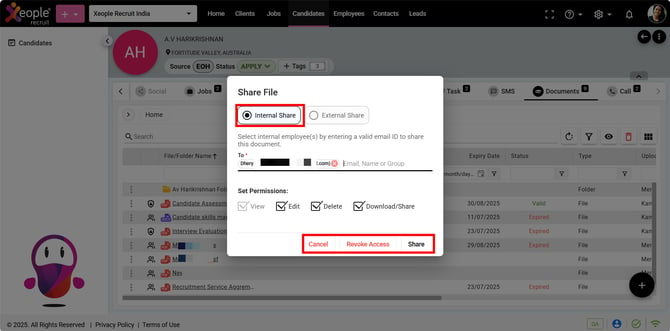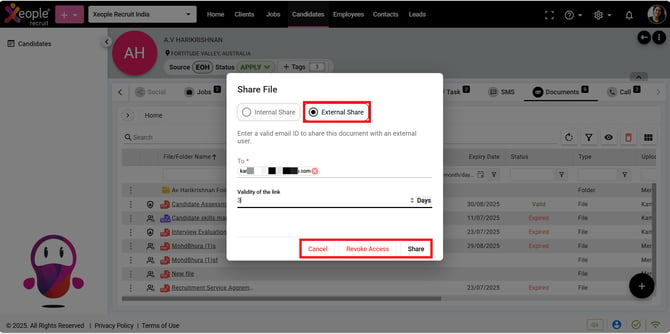Share File(s)
The Document section centralises the management of candidate, client, and job files making information easy to access, organise, and secure. You can share individual documents with internal or external users using custom permissions. Access is controlled by file-level settings, derived from the Master Data → Access Permissions initially and role-based access levels defined in User Management → Role and Access Levels.
Based on your permissions, you'll see Share and Share as Attachment options in the three-dot menu for each file.
Recommend Reading: How user role and access level works and how permissions are deriver in the file level settings, click here: Application Roles and Authorisation, Master Data – Access Permissions.
Recommend Reading: How to upload and manage access of a document, click here: Upload a Document, Document Access Rights.
To navigate to the share document page, follow these steps:
- Navigate to the main navigation header bar and, for example, click on Candidates.
- Select a candidate from the list by either clicking on the candidate or clicking the three-dot button and selecting View Summary.
- This action will take you to the candidate summary page. Navigate to the Document section and click the three-dot button next to each document.
- You will see options like: Share and Share as Attachment. Choose the option that suits your preferences.

File – Share and Share as Attachment
- Once you click the Share, you will see two options: Internal & External share, select anyone.
Read the following cases carefully to understand how the Share options appear in the three-dot menu, how they work based on your permissions, and how they affect the recipient's access—before you open the actual Share pop-up.
Share and Shared case:
- The system first checks the file’s access permissions, then verifies the user’s role-based access levels before allowing the document to be shared.
- Similarly, if the user has download/share permission, the file name appears as a hyperlink and opens in full-screen viewer with download access. If not, the system hides Share and Share as Attachment options and restricts download and sharing.
- You can re-share a Protected file with the same user, and their access will be updated with the latest permissions.
Share Permissions Logic
- You can only assign permissions that you currently have.
- File sharing permissions depend on both the file-level settings and your role's access level. Even if a file (Public) allows all actions (View, Edit, Delete and Download/Share), you can only share it based on the permissions assigned to your role access level. For example, if your role allows only View and Edit, you cannot share the file with Delete or Download/Share rights. Similarly, if Edit is disabled at the file level, you won’t be able to share the file with Edit rights—even if your role access level allows it.
All the file-based permissions are initially derived from the Master Data; you can set the access as per your needs. If in master for Public you don’t have edit rights while creating the file you will see the edit option in a disabled mode in the Access pop-up.
By default, file is shared with View permission. Other permissions are dependent on your file access permissions and role access levels.
File Sharing
|
Action |
Public |
Protected |
Confidential |
|
File Sharing |
Only External Share option by default with Download/Share permission. No internal Share. |
Internal & External Share option. |
Internal & External Share Option. |
How Internal, External and Share as Attachment works:
You cannot modify permissions for a file created or edited in Confidential mode. The owner automatically has full rights—edit, delete, and download/share—which cannot be changed or overridden.
- Internal Share: Allows sharing files with colleagues within the organisation.
- Upon clicking the Share option, Internal Share is selected by default. Enter the email address of the recipient and customise your file permissions as needed.
- Click Share.
- Once a file is shared internally, a Revoke Access button appears after sharing. Clicking Revoke opens a pop-up to remove access.

Internal Share - Email ID – Set Permission - Share
- External Share: Allows sharing documents with external stakeholders.
External shares always include download permission by default.
- Upon clicking Share, click on the external share toggle. Enter the recipient's email address and choose the link validity period and customise your file permissions as needed.
The validity of a link refers to the duration for which the shared document or link remains accessible to the recipient before it expires.
- Click Share.
- Once the access is provided, you will get an option in the same window to Revoke Access.
To revoke access to a document means to cancel someone's permission to view or use it.

External Share - Email ID - Validity of Link – Share
If a file is shared with edit permission and the Super Admin later removes edit access from the access level, future files will reflect this change and won't allow editing—but previously shared files will retain their original edit permissions.
- Share as Attachment: Facilitates document sharing by attaching them to emails.
Share as Attachment shares the file with existing permissions. You cannot edit or set new permissions while using this option.
- Upon clicking, a popup appears asking you to attach the document to your email, click Yes. An email popup appears, enter the details in the respective field and click Send Email.

Email - Document Attached - Send Email
Optional Reading: To learn more about Email Integration and how email communication syncs with calendar functionality, allowing you to schedule interviews or follow-up tasks seamlessly, click here: Sync your Emails, Microsoft 365, Sync your Calendar.
Optional Reading: How to configure Email Templates, click here: Configure Email Templates.
Optional Reading: How to setup the email signature, click here: Setup Email Signature.
Optional Reading: To read more on candidate mails, click here: Candidate Mails.
Recommend Reading: How Candidate, Client, Job file/folder are create and how the access works in details, click here: Candidate Documents, Client Document, Job Document.